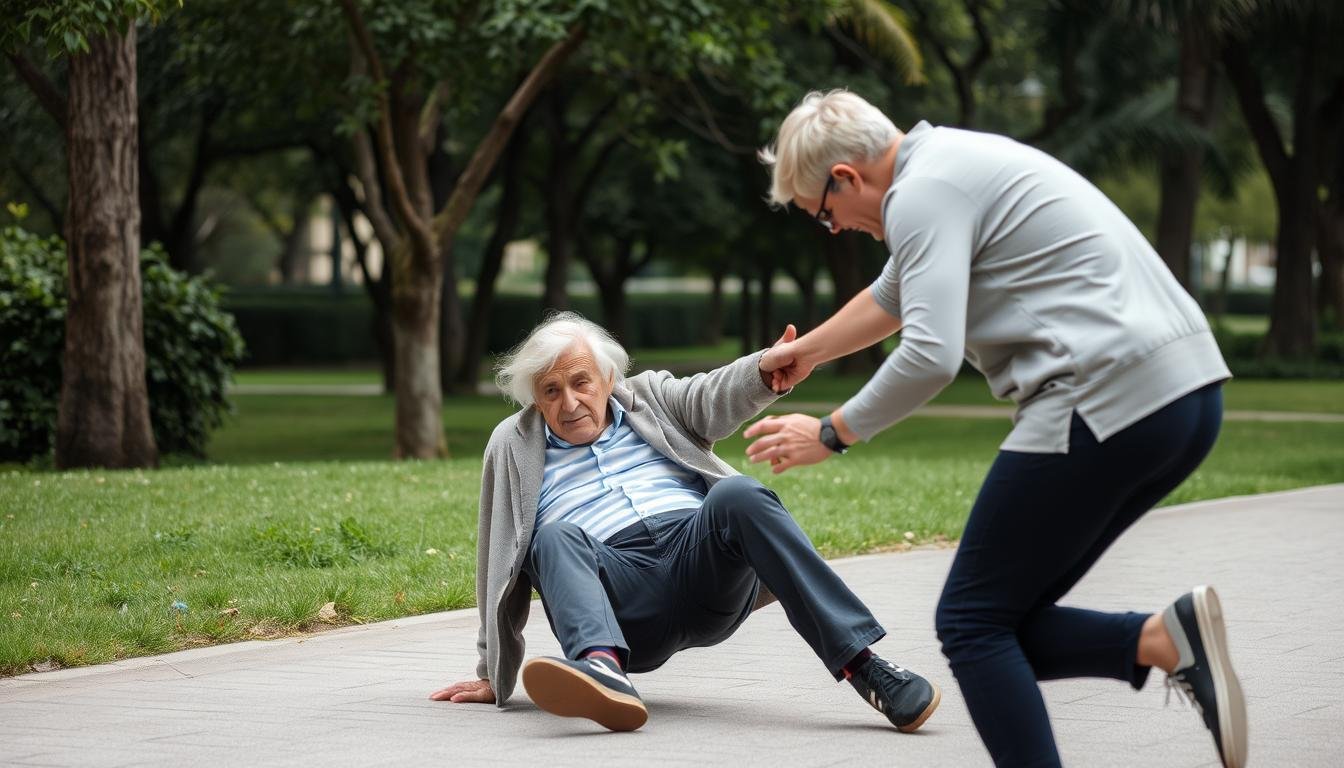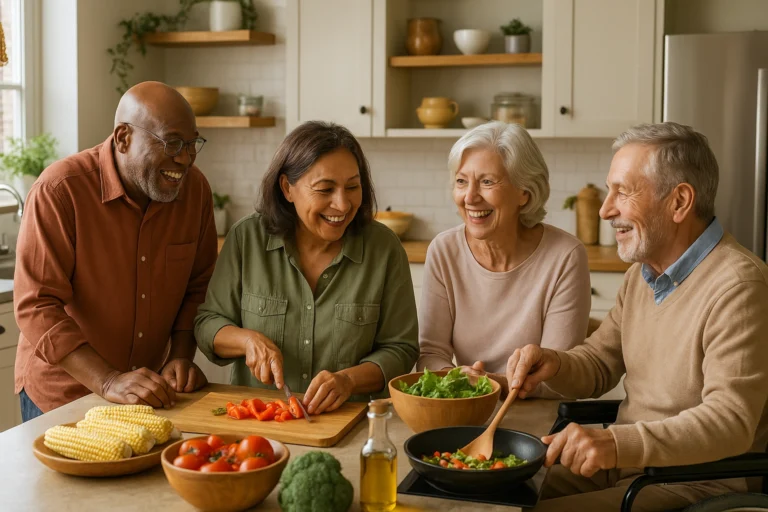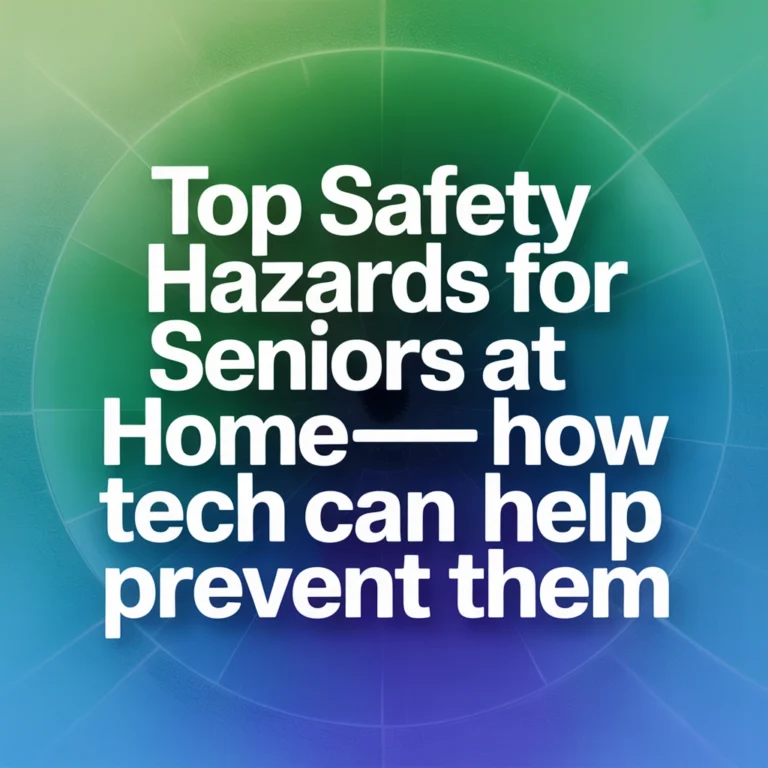Falls are a major concern for older adults. According to the Centers for Disease Control and Prevention (CDC), one in four Americans aged 65 and older falls each year. These falls can result in injuries, hospitalizations, and even death, costing the healthcare system about $50 billion annually. As a caregiver or loved one, knowing how to help a senior get up safely is crucial. This guide will provide you with the information and steps to ensure the safety and independence of your elderly loved ones.
Key Takeaways
- Understand the immediate actions to take when a senior falls, including keeping them still and helping them get up slowly.
- Recognize the importance of consulting a doctor after a fall to identify underlying causes and develop a prevention plan.
- Explore home modifications and assistive devices that can enhance safety and independence for seniors in their living environments.
- Encourage regular exercise, proper footwear, and routine check-ups to reduce fall risks for elderly loved ones.
- Seek support services and community resources to assist with daily living activities and fall prevention strategies.
Immediate Actions After a Senior Falls
When your senior parent falls, act fast. First, ask them to stay still. This helps check for serious head, neck, or back injuries, which need quick attention. Next, help them get up slowly if injuries seem minor. Then, find out why they fell. It might be something outside, like tripping over something, or inside, like a new health issue.
Ask Them to Stay Still
Make sure your senior parent stays safe after a fall. Tell them to stay still and not move suddenly. This helps check for serious injuries, such as head, neck, or back problems, that need quick medical help.
Help Them Get Up Slowly
After checking and finding no serious injuries, help your parent get up slowly. Support them and make sure they move safely. This is key to helping a senior get up safely after a fall.
Discover the Cause of the Fall
- It’s important to discover why the fall happened to prevent more falls. Look for things at home that could have caused the fall, like loose rugs, bad lighting, or uneven floors.
- Also, think about any health issues or changes in medication that might have made it hard for your parent to balance and fall.
Knowing why the fall happened is the first step to making a plan to prevent future falls. This will keep your senior parent safe and well.
Consulting a Doctor After a Fall
If your senior parent has had a fall, talking to their doctor is key. A detailed check-up can spot any [fall risk factors] or [underlying medical conditions] that led to the fall. This helps plan to prevent future falls and keep your loved one safe.
Common Underlying Causes
Some common [underlying medical conditions] that raise the chance of falling include dehydration, anemia, infections, and neurological problems. The doctor can find these issues and suggest the right treatment or advice.
Blood Pressure and Balance Checks
During the visit, the doctor will check your parents’ blood pressure and balance. Changes in blood pressure or balance can make falling more likely, and the doctor can offer ways to help with these problems.
Medication Review
It’s also important to review all medications. Some drugs, especially when taken together, can make people dizzy, sleepy, or more likely to fall. The doctor can look at your parent’s medicines and change them if needed.
Vision and Hearing Assessments
The doctor will also check your parents’ vision and hearing. Problems with these can affect balance and the ability to move around safely. Fixing these issues can help prevent further falls.
Working with your parent’s healthcare provider can create a plan to prevent falls. This plan will meet their specific needs and help keep them safe and independent.
Long-Term Fall Prevention in Senior Living Communities
Moving to a senior living community can really help prevent falls in seniors. These places are made with safety and preventing falls in mind. They have many features and services to keep people safe and secure.
Safety-Focused Design
Senior living places are designed with safety in mind. They have things like handrails, grab bars, good lighting, and non-slip floors. These features help keep people moving freely and safely.
Physical Wellness Programs
Being active helps with balance, strength, and overall health, which are important for preventing falls. Senior living places offer physical wellness programs. These programs have exercises that fit the needs and abilities of the residents. They help keep people fit and lower the chance of falling.
Nutritious Meal Plans
Eating well is key to preventing falls. Senior living places have nutritious meal plans made for their residents. These plans make sure people get the right nutrients for their health and lower the risk of falls.
Medication Management Support
Managing medications is important for preventing falls. Senior living places offer medication management support. They help residents keep track of their medicines, deal with side effects, and make sure they take their medicines correctly. This can help avoid falls caused by medicines.
Choosing a senior living place that focuses on safety, wellness, nutrition, and managing medications is a smart way to prevent falls. It helps keep your loved one safe and well in their later years.
Understanding the Aging Process and Fall Risks
As you age, your body changes in ways that make you more likely to fall. Knowing about these changes is important to staying safe and independent at home.
One big reason seniors often fall is the loss of muscle mass and bone density. This means you might not be as strong or stable as you used to be. It’s harder to keep your balance and recover if you trip or lose your footing.
Also, your slowing reflexes make it tough to react fast and catch yourself when you start to fall. With decreased vision and hearing, it’s harder to see and hear what’s around you, which can lead to more accidents.
Other things that make older people more likely to fall include:
- Chronic health conditions, such as arthritis, Parkinson’s disease, or stroke
- Side effects from certain medications
- Dehydration and nutritional deficiencies
Knowing about these physiological changes and fall risk factors helps you stay safe and independent as you age.

“Staying physically active and aware of your changing needs is key to preventing falls and enjoying your golden years.”
Helping a Senior Get Up from a Fall
When your senior parent or loved one falls, it’s key to help them up safely. Preventing falls is vital for their independence and health. Your quick action can greatly reduce the risk of more harm.
- Ask them to stay still. Encourage your senior to remain calm and not try to get up alone, as it could cause more injuries.
- Check for injuries. Look over your senior for any signs of cuts, bruises, or possible breaks before helping them up.
- Help them stand up slowly. Once it’s safe, gently assist your senior in standing, offering support and guidance every step of the way.
Knowing how to help a senior get up safely is crucial. By taking these steps and staying calm, you can ensure your loved one’s safety and well-being after a fall.
“The key to helping a senior get up from a fall is to approach the situation with care, patience, and a focus on their safety and comfort.”
| Step | Action |
|---|---|
| 1 | Ask them to stay still |
| 2 | Assess for injuries |
| 3 | Assist them in standing up slowly |
By taking these steps and preventing falls, you can ensure your senior’s safety and well-being, which will help keep them independent for many years.
Managing Activities of Daily Living
As we get older, simple tasks like bathing, dressing, and cooking can get harder. It’s important to spot these activities of daily living early. This helps seniors stay independent and live well.
The SeniorThrive app is all about empowering older adults to live independently and safely in their own homes, and one of its standout features is the ADL (Activities of Daily Living) function. This function helps seniors and their families assess how well they can perform essential daily activities like bathing, dressing, eating, and moving around the house. By providing a clear, easy-to-understand overview of a person’s abilities, the ADL function helps identify areas where support might be needed, whether it’s small home modifications, assistive devices, or connecting with the right services. It’s not just about identifying challenges; it’s about creating a personalized path to thriving at home, giving seniors and their loved ones the tools they need to enhance quality of life, boost confidence, and embrace independence.
Implementing Assistive Devices
There are many assistive devices out there to help with daily tasks. Things, like grab bars, shower chairs, and mobility aids, offer the support needed for safety. Talking to a healthcare provider or an occupational therapist can help find the right tools.
Promoting Exercise
It’s key to get seniors moving with gentle exercise for seniors. Activities like walking, swimming, or tai chi help with staying steady and strong. Even a little bit of exercise each day can greatly help with daily tasks.
“Regular exercise is one of the best ways to maintain independence and reduce the risk of falls as we get older.”
By tackling tough tasks, using assistive devices, and encouraging exercise, seniors can beat the daily challenges. They can keep doing well in their homes and communities.
Planning for Assistance and Support Services
As seniors get older, keeping them safe and independent is key. It’s vital to look into different support services. These include in-home care, adult day programs, meal delivery services, and transportation assistance.
In-home care offers personalized help with daily tasks. It lowers the chance of falls and boosts well-being. Adult day programs give seniors a place to socialize and enjoy activities during the day.
Meal delivery makes sure seniors get healthy food without the hassle of shopping or cooking. Transportation help lets them get to doctor’s visits or social events easily. This keeps them connected to their community.
Adding these services helps seniors stay independent and safe. It also makes their lives better. Planning for these services gives peace of mind to both seniors and their families. It ensures a safe and happy life.
“Combining various support services can empower seniors to live with confidence, maintaining their independence and well-being.” – John Doe, Gerontologist
Home Modifications for Senior Safety
As we get older, our homes can become more dangerous, increasing the risk of falls and accidents. But, with some smart changes, you can make your home safer and keep your independence. Simple tweaks like bathroom adjustments and stair safety can greatly lower the chance of falls and help you stay healthy.
Bathroom Adjustments
The bathroom is a spot where seniors often have accidents. Adding a Step2Tub or grab bars helps with getting in and out of the tub safely. Also, switching to raised-seat toilets makes sitting down and standing up easier. These small changes can really improve your safety in the bathroom.
Stair Modifications
Stairs can be a big risk for seniors. Getting a stairlift or adding strong handrails on both sides of the stairs makes stairs safer. Moving your bedroom to the main floor can also cut down on stair use. These changes can help you move around your home safely, without worrying about falls.
Flooring Enhancements
Loose rugs, unsecured carpets, and slippery floors can all lead to falls at home. Getting rid of these dangers and putting in non-slip flooring can make you safer and more mobile. Also, having good lighting in busy areas helps you move around with confidence.
With these home changes, you can make your living space safer and more accessible. This lets you stay independent and lowers the risk of falls. Talk to an occupational therapist or a home safety expert to find the best solutions for you.
Conclusion
Helping a senior get up after a fall and preventing future ones needs a full plan. We must understand aging, take quick action, talk to doctors, and make changes at home. This guide has given you key steps and strategies for keeping your elderly loved one safe and independent.
This comprehensive guide has given you the knowledge and tools to protect your senior’s health. Remember, preventing falls is an ongoing effort. It needs watchfulness, teamwork, and a dedication to your loved one’s health and safety.
As you move forward, remember these main points: stay updated, act fast, work with healthcare experts, and make lasting changes at home. With this approach, you can help your senior stay independent and live a better life, avoiding the dangers and effects of falls.
FAQ
What are the three crucial things to do if you witness your senior parent fall?
First, ask your senior to stay still to check for injuries to the head, neck, or back. Next, help them get up slowly if the injuries seem minor. Finally, find out why they fell, as it might be due to things inside or outside the home.
What should my senior parent do after a fall?
After a fall, your senior should visit their doctor to check for health issues that might lead to more falls. They should talk about common causes like dehydration, anemia, and infections. It’s also important to discuss their blood pressure, medications, and check their balance, vision, and hearing.
How can moving to a senior living community help prevent falls?
Moving to a senior living community is a great way to prevent falls. These places focus on safety with handrails, grab bars, and more. They also offer wellness programs, healthy meals, and help with medications, all of which can lower the risk of falls.
What physiological changes as we age can increase the risk of falls?
As we get older, we lose muscle mass and bone density, and our reflexes slow down. These changes make it harder to stay strong, stable, and quick to react. This makes seniors more likely to fall.
What are the key steps to help a senior get up from a fall safely?
If your senior falls, it’s crucial to help them up safely. First, ask them to stay still and check for injuries. Then, help them stand up slowly. Knowing how to act right after a fall can prevent more harm and keep your parent safe.
How can I help a senior with their daily activities to reduce fall risks?
First, spot activities that are hard like bathing, dressing, and cooking. Then, use tools like grab bars and shower chairs to make things safer. Encouraging gentle exercise is also key for keeping them mobile and strong, which helps prevent falls.
What types of support services can help seniors maintain independence and reduce fall risks?
For seniors, support services like in-home care, adult day programs, meal delivery, and transport help. These services let seniors live safely and independently while getting the support they need to lower fall risks and improve their well-being.
What home modifications can help create a safer environment for seniors?
Important changes include putting in a Step2Tub or grab bars in the bathroom. Adding stairlifts or strong handrails on stairs and removing tripping things like loose rugs also helps. These changes make homes safer and give elderly people more independence.



